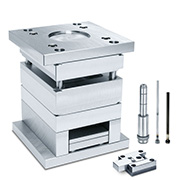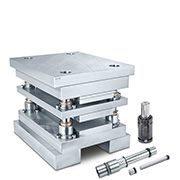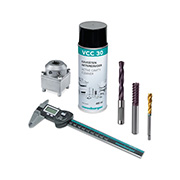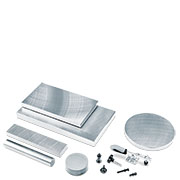The range includes two types each for direct and indirect measurement as well as suitable mounting accessories and connection technology - as usual available from stock with simple CAD data download - including installation spaces - from the Meusburger web shop.

The cavity pressure is an important parameter in process monitoring during plastic injection moulding. Pressure sensors are therefore indispensable for comprehensive mould monitoring. The use of high-quality piezoelectric sensors leads to optimal process quality and increases part quality sustainably.
Functional principle and uses of cavity pressure sensors
Cavity pressure sensors make it possible to convert the pressure in the cavity to a measurable charge by means of the piezoelectric effect. The sensors are equipped with high-precision quartz crystals (SiO2 or α-quartz) which release a charge under the influence of pressure or force. This charge, amplified by a charge amplifier, provides precise information about the pressure applied to the sensor and makes it possible to monitor the exact cavity pressure in the injection moulding process. The ideal installation position in the mould depends on the application. For example, for general monitoring and process optimisation, the sensor is placed as close as possible to the sprue or on a thicker section of the moulded part. Other typical applications are strength monitoring and monitoring or controlling viscosity, compression or shrinkage.
Direct and indirect cavity pressure sensors
Depending on the application, there are two types of pressure sensors: direct and indirect sensors, which serve for direct or indirect pressure measurement.

Meusburger E 6740 Cavity pressure sensor for direct measurement
For direct measurement, the pressure sensor is inserted directly into the cavity so the cavity pressure can be measured directly in the respective area. When pressure is applied, the sensor delivers an electrical charge in the pC unit (Picocoulomb), which is then converted into a change of pressure (bar) through the specified sensor sensitivity (pC/bar).

Meusburger E 6750 Cavity pressure sensor for indirect measurement
The indirect measurement of the cavity pressure is carried out via a force sensor which is located outside the cavity and is indirectly actuated by a force. Unlike direct sensors, the cavity pressure is transmitted to the sensor as a force via an ejector pin. In response to this force, the sensor emits an electrical charge, which is then converted into a change of force (N) through the specified sensor sensitivity (pC/N). This change of force combined with the surface of the ejector is used to calculate the pressure change.
Single Wire vs. Coaxial
Two different technologies are available on the market for charge transfer: single wire and coaxial cables.

Single wire
The single wire cable has a very small diameter. This means it can be routed flexibly with minimal bending radii in cable slots and holes and shortened as required. These cables are therefore ideally suited for moulds with limited space. In single wire technology, the mould provides shielding from the surrounding environment such as other voltage sources.
Coaxial
The coaxial cable is characterised by optimal shielding against external signals thanks to its steel sheath. The use of cavity pressure sensors with a coaxial cable is therefore ideally suited for moulds with a high number of electrical components, such as hot runner components or monitoring equipment. This variant is also used if the cable is routed outside of the mould. With the mini coaxial version, several sensor signals can be combined on one multi-channel connector.

Comparison of the two versions available at Meusburger for multi-channel connectors
| Single wire E 6760 | Mini coaxial E 6757 | |
| Signal | Can be disturbed by signals from the environment (noise) if the shielding is insufficient | No signal interference thanks to shielding against environmental influences through steel sheath |
| Cable length | Available in lengths 2,000 and 5,000; cables can easily cut to length as required | Available in consecutive lengths from 200 to 1,000 mm; can only be cut to length with a special tool |
| Cable diameter | 1.2 mm | 1.9 mm |
| Flexibility | Very flexible due to minimal bending radii but risk of kinking | Less flexible than single wire cable, but resistant to kinking |
| Installation | Easy to install thanks to the insulation displacement connector on the multi-channel connector | Easy to install thanks to mini coax female connector on the multi-channel connector |
| Price | Lower than for mini coaxial | Higher than for single wire |
Multi-channel connector
With the E 6763 multi-channel connector, the signals from 4 to 8 cavity pressure sensors can be combined with minimum cabling effort. Depending on the version, the multi-channel connectors have insulation displacement contacts for the single wire cable (version S) and mini coax female connectors for the mini coaxial cable (version C). The mould recognition is done by a chip integrated on the circuit board and enables high process reliability during mould changes. In addition, the sensor data can be easily identified with the supplied labelling plate.

Connection options
The different connection options for direct and indirect cavity pressure sensors are shown in the following figures.





 © 2024 by Meusburger Georg GmbH & Co KG | All rights reserved
© 2024 by Meusburger Georg GmbH & Co KG | All rights reserved





 Česká republika [CS]
Česká republika [CS]
 Danmark [DA]
Danmark [DA]
 Deutschland [DE]
Deutschland [DE]
 España [ES]
España [ES]
 France [FR]
France [FR]
 India [EN]
India [EN]
 Italia [IT]
Italia [IT]
 Magyarország [HU]
Magyarország [HU]
 México [ES]
México [ES]
 Nederland [NL]
Nederland [NL]
 Österreich [DE]
Österreich [DE]
 Polska [PL]
Polska [PL]
 Portugal [PT]
Portugal [PT]
 România [RO]
România [RO]
 Schweiz [DE]
Schweiz [DE]
 Slovenija [SL]
Slovenija [SL]
 Srbija [SR]
Srbija [SR]
 Suomi [FI]
Suomi [FI]
 Sverige [SV]
Sverige [SV]
 Türkiye [TR]
Türkiye [TR]
 United Kingdom [EN]
United Kingdom [EN]
 USA [EN]
USA [EN]
 Ελλάδα [EL]
Ελλάδα [EL]
 България [BG]
България [BG]
 Росси́я [RU]
Росси́я [RU]
 华 [ZH]
华 [ZH]